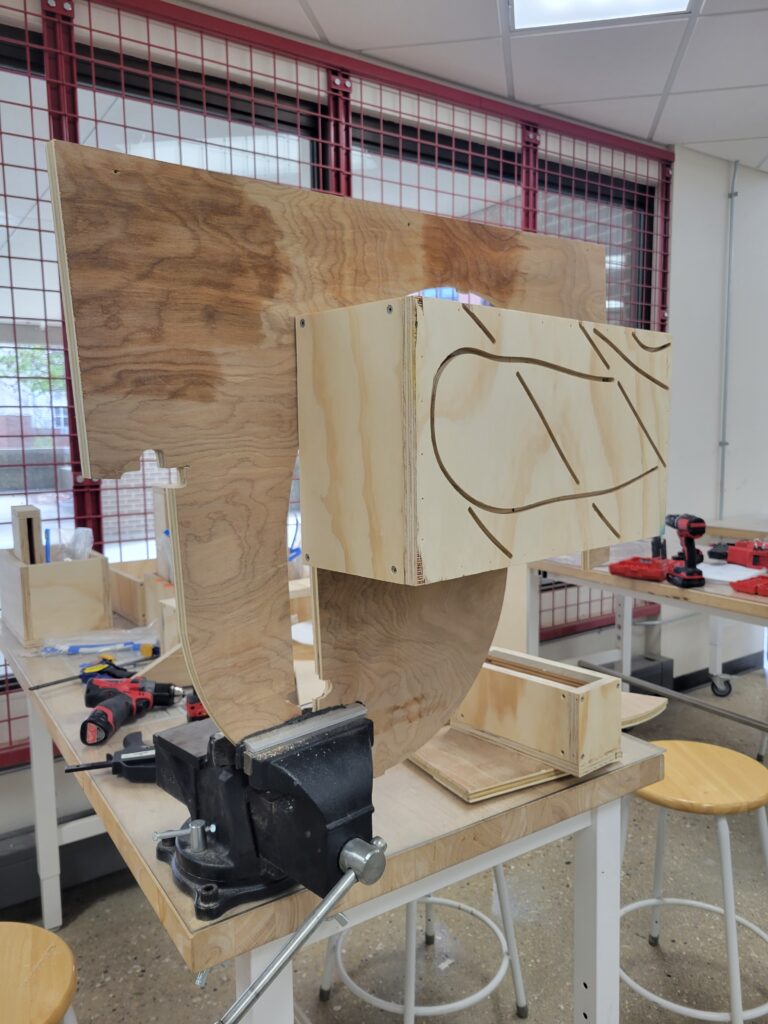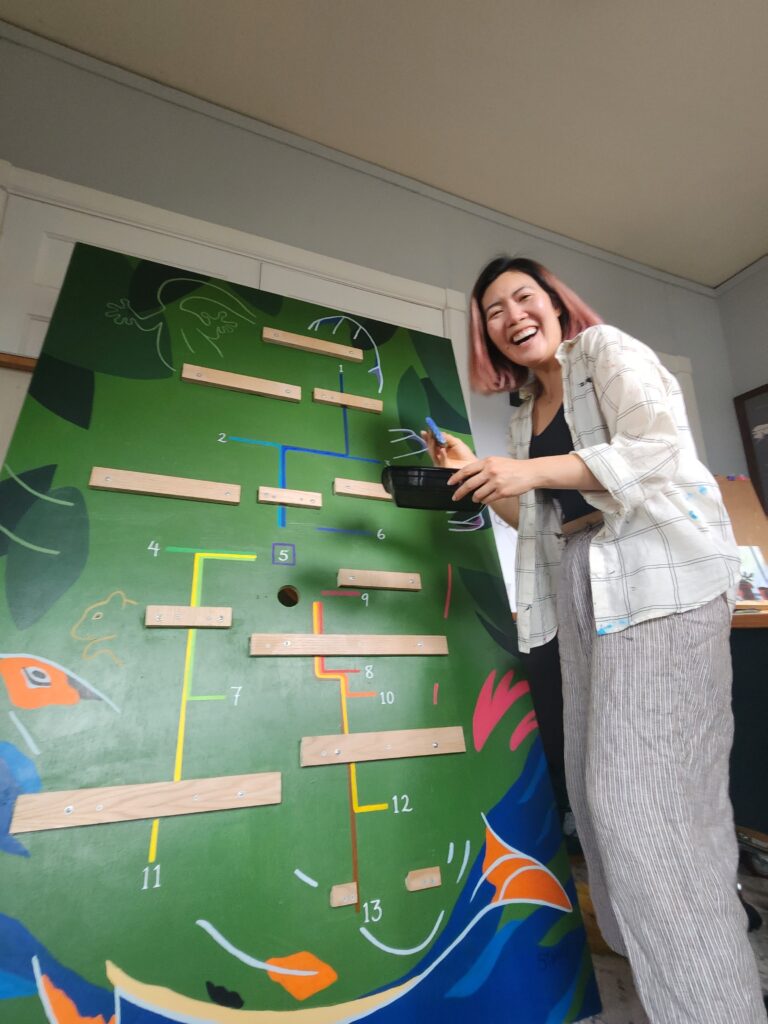Like the recipe book for life, every living creature has DNA. DNA contains genes, which contain instructions for making proteins. There are many types of important proteins that impact the way our body functions. Transcription factors (TFs) are a special protein that controls what other proteins are made by directly interacting with DNA to turn genes “on” or “off.”

The newest art installation at our Biopharmaceutical Technology Center Institute (BTCI) brings this concept to life. “Genetic Symphonies: Building Hox of Life” uses a human skeleton to showcase how TFs turns on Hox genes by flipping the switches in the correct order. Hox proteins are a special TF that function during growth and development—and all mammals have them. There are 13 groups of Hox TFs (Hox1-Hox13) and unlike other proteins, Hox TFs must be made in a certain order for proper development to occur, starting with Hox1 and ending with Hox13.
In this interactive exhibit, the user is a TF and must turn on Hox genes by flipping the switches in the correct order on a control podium. Every switch (Hox gene) you flip will be accompanied by light and sound (Hox proteins), representing the production of Hox TF proteins. If you successfully turn on all 13 light switches in the correct order, then the entire skeleton will be lit up, orchestrating your own developmental symphony.
Meet the Artists
From conception to creation, this project took Graduate students Katharine Hubert and Sharon Tang seven months to build. They created this interactive art and science fusion exhibit at UW Markerspace during their participation in the Marie Christine Kohler Fellowship at the Wisconsin Institute of Discovery (WID). During that time, they failed, learned new skills, and spent many hours troubleshooting, ultimately succeeding in bringing their vision to life. However, there is much more to the Genetic Symphonies exhibit, conceptually and logistically, than what is presented.


Katharine (Kat) is a composer and patient-scientist currently in the fifth year of her Genetics Ph.D. Her personal journey with a genetic condition drives both her artistic creativity and her dedication to scientific research, inspiring her to address gaps in scientific knowledge. As a leader in disability advocacy within STEM, Kat has developed accessible lab equipment for inclusive, accessible practices—some of which are showcased in this piece of artwork
Sharon, a mural artist and scientist in the fifth year of her Cellular and Molecular Biology Ph.D., draws on her educational background to create public art that fosters discovery through viewer-led experiences. With a passion for simplifying complex concepts into digestible access points, she believes art can connect people to content and spaces they might otherwise find unapproachable. Sharon aims to continue developing interdisciplinary projects that facilitate science engagement through informal and exploratory learning.
Harmonizing the Sound of Science
Much like science, the composition process was both creative and experimental. While several variables were changed during the creation of the tune, there were a few constants that were critical to accurately capture and convey the musical essence of this scientific concept.
Thirteen unique instruments were used, each representing one Hox gene group. These instruments include the marimba, timpani, xylophone, vibraphone, bass drum, hand clap, high-hat, bongo drums, cello, plucked viola, woodblock, piano, and chimes. The music is a progression meaning a new instrument is added to the tune with each subsequent button press. This progression reflects the cumulative effect of development, illustrating how the expression of a given Hox gene group depends on the appropriate expression of the preceding group. Each previously activated group, or instrument, remains active, ensuring the next can function. If a user fails to follow the correct sequence, a soft error sound, similar to a buzzer, signals the misstep.
Engineering the Experience
Though not visible to the user, this exhibit relies heavily on electrical engineering, Raspberry Pis, and logic-based code to function. Raspberry Pis, compact computers containing the logic-based code, play a crucial role. Genetic Symphonies uses two of them: one positioned underneath the buttons on the podium (the sender), and the other housed in the central box of the art panel (the receiver).
Radio Frequency (RF) Transceiver Modules are wired to the Raspberry Pis, enabling them to send and receive signals. The code stored on the Raspberry Pis orchestrates the activation of light and sound. It contains the correct sequence of button activation and dictates when information should be sent to the receiver Raspberry Pi.
For the buttons to make sound, or the lights to turn on, they must be physically connected to the Raspberry Pi. This is done by wiring the buttons/light to one of 40 potential pins in a Raspberry Pi:

Each button or light is associated with 2 wires, which link them to the Raspberry Pis. Once connected, the Raspberry Pis collaborate to interpret the code. Each Raspberry Pi contains unique code that allows them to either send or receive signals. When all 13 buttons are pressed in the correct order, the sender/buttons Raspberry Pi triggers the full musical sequence, while the receiver/lights Raspberry Pi initiates a 31-second countdown—the length of the entire musical tune. At the end of the countdown, the lights turn off and the code resets, preparing the system for the next interaction.
Celebrating Genetic Symphonies
Sharon and Kat’s journey in creating Genetic Symphonies is a testament to their creativity, perseverance, and expertise. From conceptualizing the exhibit to meticulously executing every detail, their hard work shines through in every aspect of the project. “Both Sharon and Kat have been outstanding stewards of the Kohler Fellows program and ethos. Their exhibition reflects an incredible amount of hard work and dedication that would not be possible without a strong foundation of support,” says Andrew Hanus, Director of the Illuminating Discovery Hub at WID and the manager of the Kohler Fellows. “We are so incredibly proud of them and what they’ve accomplished.”
Take a look behind the scenes with more photos from the building process of Genetic Symphonies!





Riley Bell
Latest posts by Riley Bell (see all)
- Genetic Symphonies: Building Hox of Life - December 17, 2024
- Exploring the World Through the Promega and Eppendorf Family Exchange Program - November 19, 2024
- Lab Safety: The Catalyst for Every Great Experiment - September 26, 2024
